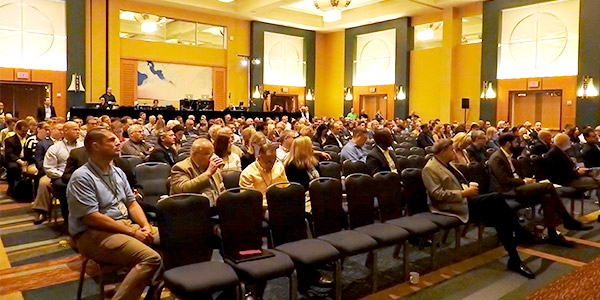By Christen Smith
CAMBRIDGE, Md. — As PJM considers how to best manage future carbon policies, energy industry experts say the unique challenges the RTO faces can be mitigated with strong coordination between policymakers, stakeholders and grid staff.
“You’re not the only ones looking at this,” Dirk Forrister, CEO of the International Emissions Trading Association, said during the General Session of PJM’s Annual Meeting, at the Hyatt Regency Chesapeake Bay Golf Resort, Spa & Marina, on Wednesday. “It is material, and it seems to be an issue, in terms of public sentiment, that’s coming up more and more.”
Forrister, who once served as chairman of the White House Climate Change Task Force under President Bill Clinton, said the U.S. remains an “outlier” internationally as other countries embrace carbon pricing, with varied levels of success.
“Come on in, the water’s fine,” he said. “To get to the levels of climate protection that governments want, it implies a level of reduction that we haven’t seen before.”
PJM isn’t the first RTO to tackle carbon pricing, but its challenge of balancing the markets between participating and nonparticipating states proves unique compared with NYISO and CAISO.
In New York, NYISO is close to voting on a set of rules to price carbon that would include border charges for imported power and credits for exported power — just one way PJM could handle flows among its 13 states and D.C. (See More Details Divulged on NYISO Carbon Pricing Study.)
In CAISO, where power also flows to and from regions without carbon-reduction goals, operators prioritize curbing emissions over importing energy from the cheapest resources. It’s a focus that Ben Grumbles, Maryland’s secretary of the environment, encourages PJM to take as it examines how pricing could work across the grid.
“A carbon-constrained energy sector is absolutely the future,” he said. “Never lose sight of the fact that the goal should be to reduce emissions.”
Maryland and Delaware both participate in the Regional Greenhouse Gas Initiative, a coalition of Northeast and Mid-Atlantic states committed to capping carbon emissions from the power sector. Emissions have been cut in half since 2014, and more than $3 billion have been reinvested into cleaner energy and ratepayer reductions, Grumbles said.
“In RGGI, the key is to have the environment secretary for the governor and the energy regulators together so we can we find common ground,” he said. “It takes time.” He also emphasized the importance of preserving state sovereignty and protecting consumers from “windfall profits.”
Anthony Giacomoni, senior market strategist for PJM, said an ongoing internal study is quantifying the market impacts of a systemwide carbon price, versus a regional or sub-regional system.
“We want to enable state policies while preserving economic and competitive dispatch,” he said, noting that minimizing “carbon leakage” remains a top priority. “High prices will have very high leakage and, as a result, prevent states from reaching carbon-reduction goals.”
Staff are also considering one-way and two-way border adjustments as other tactics to minimize the impact on nonparticipating states and maintain a level playing field for dispatching generation. While not an “exhaustive” study of all the ways PJM could accommodate carbon pricing, Giacomoni said the RTO hopes it will better inform policymakers and stakeholders of the market impacts.
He said staff will provide an update on study results at the May 15 Market Implementation Committee meeting, with a plan to release the full analysis later this summer.





